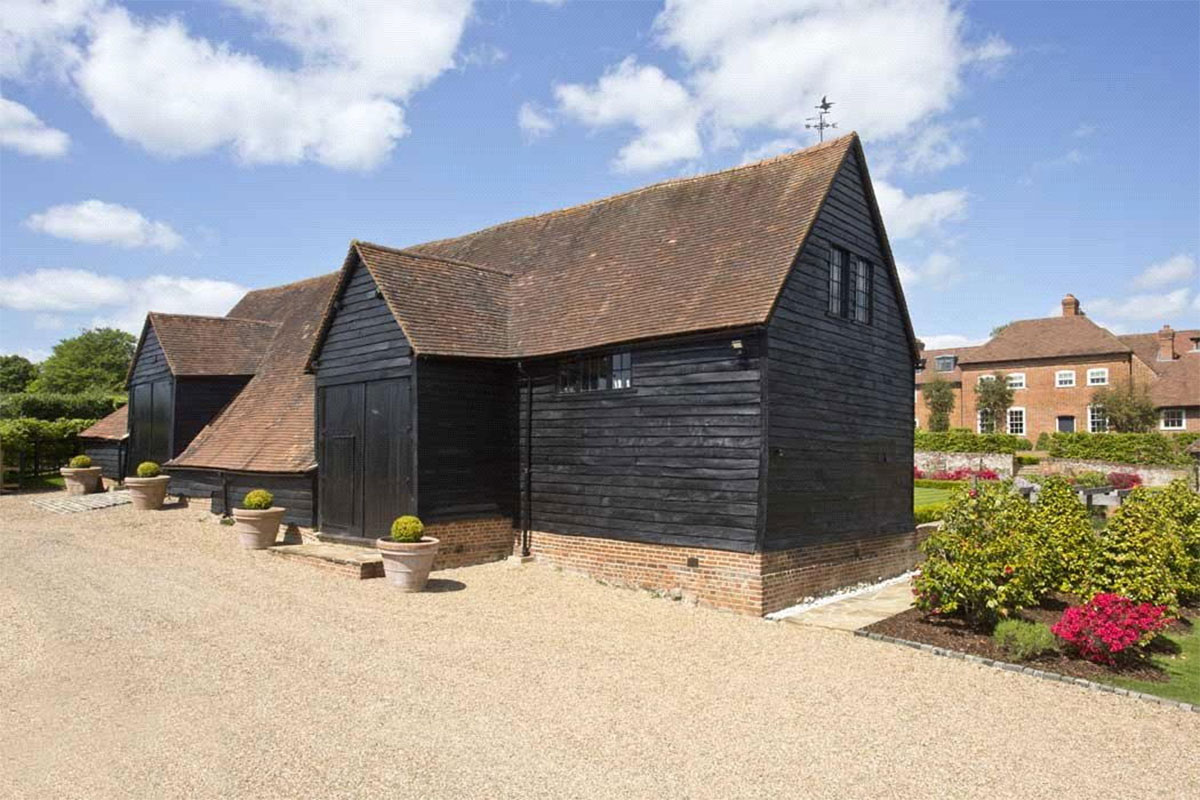
Earlier this year a house came to the market with a number of claims to fame. At £15 million via Knight Frank, it was one of the most expensive homes on the market in the Home Counties. It has a stunningly rare early 1970s Ferrari 312PB parked in one of the reception rooms. And perhaps most strikingly of all, it has a barn that's built from the timbers of the Mayflower, the iconic ship which took settlers from England to America in 1620 to set up the first Anglophone settlement in the New World.

A USP that's genuinely unique: Old Jordans in Buckinghamshire.
We know what you're probably thinking, because we were thinking it too. Really? Timbers from the Mayflower? It's a claim that feels utterly outlandish, like the hawkers who sell 'fragments of the true cross' to pilgrims at Jerusalem or Lourdes. Surely it's not possible?
We couldn't help but dig a little deeper, and the story behind it is utterly fascinating... because there's a decent chance that the story really is true.
Let's start with the Mayflower herself. No documents have survived providing full details of the ship, but she's believed to have been a 90ft, 180-ton ship built in the early 17th century, registered in Harwich, and bought by Christopher Jones in 1608. This was no purpose-built vessel designed for emigrés, but a merchant vessel chartered for a one-way voyage across the Atlantic, carrying the 102 settlers who headed off to a new life in the New World in the last days of the summer of 1620.
After an abortive start in August — during which the pilgrims' other ship, the Speedwell, turned back having sprung a leak — the voyage truly got under way from Plymouth on 16 September. 66 arduous days later, on November 21, the Mayflower landed at Cape Cod, stopping for a few weeks before heading out once more and setting down at Plymouth Rock, Massachusetts, on December 26, 1620.
The Mayflower stayed put for several months as the pilgrims got on with beginning their new lives at a brutally cold time of year, mostly due to the appalling death rate of those on board, with disease, terrible conditions and malnutrition killing off half the settlers and crew. In April the Mayflower finally got back under way once more to complete the return journey, crossing the ocean in four weeks despite damage to the ship and the decimated crew.

The Mayflower braving high seas which blighted its journey, as pictured in this 1893 engraving.
Nothing is known of what happened next to ship until an assessment of her value in 1624, carried out to determine the size of the estate of her recently-deceased owner. Ship surveyors from the Admiralty valued it at the satisfyingly exact sum of £128, eight shillings and fourpence.
Exquisite houses, the beauty of Nature, and how to get the most from your life, straight to your inbox.
And after that, the Mayflower disappeared from history for almost three centuries.
It might have stayed lost in time until an elderly academic named James Rendel Harris bumped into someone at a funeral who told him that the Mayflower had been used to build a barn on a farmstead in Buckinghamshire. Rendel was a biblical scholar of some renown — so much so that two portraits of him are in the collection of the National Portrait Gallery — but had no background in maritime history until starting his investigation, which culminated in him writing a short book called The Last of the 'Mayflower'.
The book caused a sensation, as recounted by modern historian Dr Tom Hulme in his entertaining telling of the story for the Mayflower 400 celebrations. 'Scores of people came flocking from around the country (and even the United States) to catch a glimpse of the interior,' he writes. 'Amazed or dubious, journalists reported the most incredible of happenings: an Englishman, James Rendel Harris, had found the last resting place of the Mayflower.'

An illustration of the 'Mayflower Barn' in Country Life, June 19, 1942.
Among the true believers were many sceptics, who tried to tear down Rendel Harris's argument — much of which, it has to be said, is highly speculative. It also seems that the author had more than a scholarly interest in following the evidence: he was a Quaker who had recently opened a hostel in the village, had written a number of plays about the Mayflower, and was a member of hte Mayflower Club. As Hulme concludes, 'Harris had a motive – "providentially happy" as one newspaper put it – to unexpectedly find the Mayflower in Jordans.'
To read the story from that cynical viewpoint seems a little ungenerous, though, not least because spinning a yarn to line one's pockets seems like the exact opposite of the behaviour you'd expect of a Quaker.
So while some of Harris's extrapolations in his book might stretch credulity, there is plenty of evidence that shows that this really could be the Mayflower as an article on June 19, 1942 in Country Life looking at barn construction notes:
Dr. Rendel Harris has produced a mass of evidence to support a similar local tradition that the barn at Jordans, near Beaconsfield, was fashioned from the timbers of the Mayflower.... Several millionaires hani offered an open cheque for the historic barn, but the Society of Friends [Quakers] wisely preserves this treasured relic... Of chief interest is the cracked tie beam which is claimed to be the original main beam of the vessel. According to Bradford's journal [William Bradford, Governor of the Plymouth Colony] the pioneers were greatly troubled by a cracked main beam which was finally repaired with rivets from the printing press.'
Those jigsaw pieces fit, then, as do many others — and with no other obvious alternative explanations for the Mayflower's final resting place, accepting Harris's claim seems as good an idea as any, as Brian Dunning wrote in Country Life on September 10, 1970, on the occasion of the 350th anniversary of the journey:
'Sooner or later all pilgrims of the Pilgrims make their way to the barn in the grounds of the Quaker hostel at Jordans in Buckinghamshire, said to have been built from the timbers of the Mayflower. That the timbers came from a ship contemporary with the Mayflower is hardly in doubt: that they came from the Mayflower itself is more debatable, but the speculation is attractive, particularly as we shall almost certainly never know the answer.'
Historic England seem to agree, not definitively agreeing that this barn is made from the Mayflower, but simply saying that the Grade II-listed barn is 'held by some to incorporate timbers from the Mayflower in which the Pilgrim Fathers sailed in New England in 1620.'

The Mayflower Barn's interior was once a small museum about the voyage of the Pilgrim Fathers, as shown in this 1970 photo from Country Life.
For many years, the barn was open to the public, but it was sold off and the house on the site redeveloped into the grand, modern home that you now see on this page.
The interiors of Old Jordans are about as far from the cramped, dark conditions on board the Mayflower as it's possible to imagine. This is a bright, modern, and incredibly grand home, which is being sold off-market by Knight Frank.






There are 10 bedrooms, 10 bathrooms, huge glass walls and the sort of look and feel you'd expect of a high-end hotel, rather than a family home near Beaconsfield. Most striking of all is the car displayed proudly in one of the reception rooms: it's a Ferrari 312 PB, dating to the early 1970s, a model which the Italian marque used to win the World Sportscar Championship in 1972.

We don't know which exact example this is, but these are rare beasts indeed: a Ferrari 312 PB sold via Sotheby's for £10 million a couple of years ago. How lovely to think that this icon of 20th century transport has its final resting place so close to that of an icon of 17th century transport.
Old Jordans is for sale off-market via Knight Frank, with a guide price of £15 million (the Mayflower Barn is included; the Ferrari isn't).







Toby Keel is Country Life's Digital Director, and has been running the website and social media channels since 2016. A former sports journalist, he writes about property, cars, lifestyle, travel, nature.


